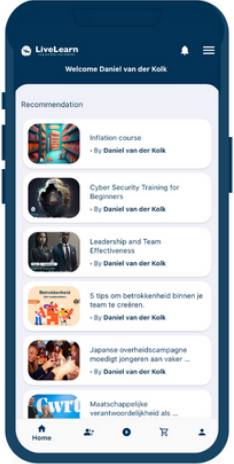
Artikel
04
October
Influence: the 7 principles of Cialdini
You’ve likely come across Cialdini’s 7 principles before. They’re the essential foundation every marketer should be familiar with to ensure the success of their business. These principles teach you how to influence the behavior of your customers or visitors.
In this article, I’ll introduce you to Robert Cialdini, outline the 7 principles he describes, elucidate their impact on your brain, and demonstrate how you can apply them in your marketing communications.
Who’s Robert Cialdini?
Cialdini is a professor of Psychology and Marketing at the University of Arizona. You probably recognize him as the author of the book “Influence.” In this book, Cialdini outlines six principles for persuading people. In 2016, he authored another book where he introduced a seventh principle to the persuasion process, titled “Pre-Suasion.”
Navigate quickly through the content
1. Reciprocity
-
-
- downloadable resources;
-
- informative newsletters;
-
- webinars;
-
- exclusive discounts.
-
For instance, this webshop provides discounts to customers who subscribe to their newsletter. By doing so, they hope to encourage customers to make a purchase sooner, leveraging the principle of reciprocity to cultivate loyalty and engagement.

2. Liking
The likelihood of making a purchase from a store with an unfriendly and unapproachable salesperson is minimal. Instead, we naturally gravitate towards businesses and individuals we know, like, and trust. This is where the principle of liking comes into play.
Practically implementing liking:
How can you ensure that customers are drawn to do business with you? The key is to humanize your organization. People prefer interacting with individuals rather than faceless entities. Showcase the human side of your company by featuring photos of your team on your website and sharing “behind the scenes” glimpses on social media.
Moreover, prioritize user experience on your website. Nothing is more off-putting than slow-loading pages or broken links. Enhancing the browsing experience is a manifestation of liking. By making interactions smoother for your visitors, you increase the likelihood of conversion.
Other effective strategies for applying liking:
Utilize visually appealing images of people or products that catch the eye. Offer compliments to customers or highlight their accomplishments to foster positive associations. Extend birthday wishes to customers’ family members, showing personal care. Highlight the charitable initiatives your company supports, demonstrating shared values.
Example from our client: Certina, a watch brand, adeptly incorporates this principle. Beyond merely showcasing their products, they feature models on their website, adding a human touch to their brand presentation.

3. Consistency

Another effective persuasion technique involves obtaining “yes” responses to smaller requests, known as soft conversions. Encourage customers to engage in simple actions like following your Facebook page or sharing your posts on LinkedIn. When you subsequently present a larger request, they’re more inclined to comply. This principle capitalizes on our natural tendency to follow through on commitments and previous actions.
In essence, soft conversions serve as precursors to larger conversions, priming individuals to be more receptive to subsequent requests.
4. Scarcity
The allure of a product or service intensifies when it’s perceived as scarce, a phenomenon known as the principle of scarcity. Interestingly, we all succumb to this tendency, often without even realizing it!
Practical application of scarcity:
A quintessential example of this principle in action is evident on booking.com. The ubiquitous “only 1 room left” notification is a prime illustration of leveraging scarcity to drive bookings.
Scarcity extends beyond product availability to include scarcity of time. By instilling a sense of urgency and emphasizing limited availability, you can prompt customers to act swiftly. Utilize phrases such as:
- “Only ‘x’ items left in stock”
- “This offer expires in ‘x’ days”
- “While supplies last”
By incorporating scarcity into your marketing strategy, you create a compelling incentive for customers to make decisions promptly, maximizing conversion rates.
5. Authority
Another principle consumers (often unconsciously) respond to is the principle of authority. When someone in a white coat advises us to walk for 30 minutes daily to maintain good health, we’re more likely to accept it as truth compared to if the same advice came from a family member. Interestingly, this individual doesn’t necessarily have to be a genuine doctor; the illusion of authority alone is sufficient to activate this persuasive principle.
Authority in practice:
We inherently trust experts. Therefore, it’s crucial to establish yourself as one! Display your credentials proudly by showcasing your diplomas, adding certificates to your LinkedIn profile, or highlighting any awards you’ve received on your website. This serves to reinforce your authority and expertise in the eyes of your audience, enhancing the effectiveness of your persuasive efforts.
6. Social proof
We tend to follow the actions of others and make choices based on their decisions. It’s a familiar scenario; if colleagues don’t close their laptops until after 5:00 PM, chances are you won’t either. This phenomenon is known as the power of social proof.
According to evolutionary psychologists, this behavior stems from our innate desire to belong to a group. When faced with decisions, we naturally look to others to guide our choices.
Practical application of social proof:
Social proof is most commonly utilized in the form of reviews. Visitors often harbor uncertainties, which are alleviated when they see positive feedback from others about your product or service.
An exemplary case from our partner, Leadinfo B.V., demonstrates this effectively by showcasing customer reviews. This fosters trust and assurance among potential customers, making them more inclined to make a purchase.

6. Unity
You’d do anything for family. You’d go through fire and water for them. That’s the power of unity. In his book “Pre-Suasion,” Cialdini discusses how to influence others (beyond just family) using this principle.
This principle revolves around camaraderie and connectedness: the sense of “we.” You’re more likely to buy from a seller you feel a connection with.
Unity in practice: There are various ways to apply this principle. Here are a few examples:
Co-creation: Involve customers in the production process. Contests where parents can win something for their child. Build a community and share stories.
Are you eager for more tips on persuasion?
Your brain is currently processing a lot of information. Take it easy and relax! If you’re still keen on receiving more persuasion tips, feel free to check out our other articles or get in touch with me!
What's your reaction ?
Follow us on Social Media
Recent posts

December 15, 2025
Hoogste Europese rechter bevestigt minimumloonrichtlijn EU-landen

December 09, 2025
Non-bancaire financiering: zó regel je dat

December 05, 2025
Deadline kleineondernemersregeling (KOR) 2026 nadert

December 01, 2025
Inzicht in je cijfers: zo haal je meer winst uit dezelfde omzet

November 27, 2025
Productiviteit stagneert: hoe zorg je voor verandering op de werkvloer?

 Inloggen
Inloggen
 Registreren
Registreren






Comments (0)
No reviews found
Add Comment